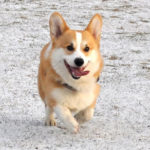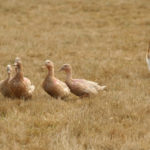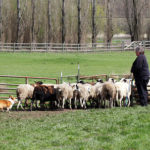Today’s post is affectionately dedicated to my Dad, who (until now) has never seen a Corgi herd. Hang on to your hat, Dad — they don’t just herd mice!
To start the dog, most people take the dog into a small area with some very dog-broke (trained) sheep that will stick with the handler. The dog is turned loose on the stock and allowed to use their instinct to gather the sheep. Most dogs like to fetch, which means they want to bring the sheep to the handler. So the dog will circle the sheep to try to keep them together and with the handler. The handler’s job is to direct and guide the dog to where they want them to go, then learn to change directions on command, stop in a particular place on command, and eventually learn to modify the circling behavior when the dog is at “balance” to keep the sheep headed to the handler.
Once a handler and dog learn together and have a good partnership, the dog learns to work against his instinct to bring sheep and works on driving, or moving the sheep away, from the handler — in whatever direction the handler asks of the dog.
The rewards are incredible. I feel like my dogs and I have a stronger bond and better understanding of each other because of herding. It’s a beautiful sight to see your dog actually working sheep or cattle or whatever stock, doing what they were bred to do. And when you work so hard at an activity and it all goes right, there is no better high. I have done multiple dog sports, and can say that herding is the hardest, most frustrating thing I’ve EVER done with my dogs, but it is also the most fun and the most rewarding thing I’ve ever done.
In addition to all that, I have also made close friends in the herding world. We spend time as a group helping out at the herding facility we train at. So I spend more time outdoors and get to help care for livestock, and my dog gets to do “real” farm work! Working livestock also gives the dog a genuine sense of accomplishment and self worth, which gives them confidence in all walks of life.
Quigley (M-Tak’s Fire Down Under PHC, PT, JHDs)
Q: What trials have you entered (and won?)
Vinnie is my six year-old who has LOTS of drive and has been gung-ho to work sheep since he first saw them at 14 weeks old! He didn’t get to start his formal training until he was over a year old, mature enough mentally and physically to handle the job. He has been trialing for about four years now. I think he has done well and I’m extremely proud of how far he has come. He has so far earned multiple beginning and intermediate level titles in AKC, ASCA, and AHBA, working on multiple different courses. He is the first and only Pembroke Welsh Corgi to have earned titles on all three courses AKC offers. Each course requires very different skills and style of working, so not many dogs train and compete on all three courses.
Vinnie has worked small groups of three sheep and larger groups of 25-30 sheep. He’s worked ducks as well. Some of the courses are in arenas, some are in open fields, some are in large pastures, and some are on a working farm in barns, fields and/or pens.
Each organization awards a title once the dog has qualified on the same course, with the same stock, either two or three times (AKC – 3, AHBA & ASCA – 2). So you can actually earn separate titles on the same level of the same course on different stock. For instance, you can earn a Started (beginning trial level) Course A – sheep title and a Started Course A – duck title. There are 3 levels – beginning, intermediate and advanced on either cattle, sheep or ducks. Each level is more difficult in the skills required and the distance in which the dog has to work away from the handler.
photo: Bruce Allert
Q: Do Corgis herd differently from other breeds — for example, Border Collies?
The Corgi, on the other hand, was used as a more all-around farm dog in Wales, particularly to work cattle. They would help drive the cattle to town or to grazing pastures as needed. Since grazing pastures were generally not fenced, the Corgi would also “guard” their own pasture and stock and drive/chase off any cows that wandered in from the neighboring farms. They also were the farm “ratters”, in addition to alerting the family to strangers by barking. The farmers, being poor, wanted a dog that was easy to keep and didn’t eat much. Knowledge of the traits necessary in developing the Corgi explains a lot about their personalities. They needed to be pushy and tough to work cows; smart yet independent; alert and vocal. This developed a dog that tends to work very close to the heels of their stock and are “pushy”, often using their bark or nipping to help move the stock. The biggest challenge of modern day herding with Corgis — especially when working sheep — is to get them to back off and not be so pushy.
I do think there is a very positive effect on the level of “control” that a person gets over their dog AND the level of self-control the dog gets from herding. The dog learns to listen to and work with the person in the face of a GREAT prey (chase) drive! And they also learn to have more self-control around all kinds of “critters” (geese, bunnies, etc). Once they have been training in herding for awhile, they learn how to work in a controlled and more relaxed state. They stop thinking about “chasing” animals and learn that there is a time to work and a time to ignore them. I feel that if a person can get a dog to listen and stop working livestock on a verbal command, then they should be able to get them to listen in just about any distracting environment!
General Terms:
Balance: When the dog is in position to bring the stock in a straight line to the handler. As the handler’s position shifts, the dog should reposition accordingly.
Cross Drive: When the dog is taking the livestock across the field in a straight line in front of the handler.
Drive: Any time the dog takes the stock in a direction away from the handler.
Eye: An inherent characteristic of working dogs which allows the dog to control the livestock. Too much eye in a dog can have a hypnotic effect on the dog and adversely affect his/her ability to move stock.
Fetch: Any time the dog is bringing the livestock in a straight line toward the handler.
Flank: From the dog’s perspective in relation to the stock, a circular movement either clockwise or counter-clockwise around the stock.
Flight Zone: The invisible area around a group of stock that, when crossed by an ‘outsider’, causes movement in the bunch. The flight zone changes under different circumstances, such as the power or ‘presence’ of an individual dog.
Grip: When the dog bites the stock. For both sheep and cattle, an “acceptable” grip is either on the nose or low on the heel or hock, and is usually done at the handler’s command.
Heading: Generally, when stock are leaving or trying to “escape,” the dog will run in an arc to their heads and come up in front of them to stop them.
Heeling: When the dog bites the stock on the hock or low on the heel to make them move. Done more often with cattle than sheep.
Hold: The dog holds the livestock in a stopped position.
Instinct: The inherent ability in a stock dog to work livestock. We cannot teach a dog to work if it does not have instinct.
Lift: The moment when, after the outrun, the dog first comes in close enough to the stock to influence them and move them. The very first movement of the stock.
Outrun: When the dog leaves the handler’s side, runs out in an arc to either the right or left, and comes up behind the livestock to gather them.
Pen: When the dog and handler, in a joint effort, put the livestock into an enclosed area.
Pressure: The influence on the stock by the dog’s presence and inherent “power” — the amount of which will determine the behavior of the stock and their flight zone for that particular dog.
Shed: Separating 2 or 3 head from the rest of the flock and preventing them from regrouping.
Sort: Sorting livestock. To put certain individuals into different areas, usually done with gates and pens.
Walkabout: When the handler just walks around the field, often making either S curves or very square turns, with the stock behind him/her, and the dog behind the stock, bringing the stock toward the handler. The turns are to teach the dog to reposition so as to always be in balance with the handler. An exercise generally done with young dogs.
photo: Gabriel LaRoche
Basic Commands:
Away to Me: The traditional command that sends the dog in a counter-clockwise movement around the stock.
Come Bye or Go Bye: The traditional command that sends the dog in a clockwise movement around the stock.
Get Around: A command used to send the dog around the stock in a direction of the dog’s choice.
Get Back: A command used to tell the dog to turn away from his/her stock, move farther away, and then turn to face them after having moved. Used to take the pressure off the stock.
Get Out: A command used to tell the dog to move out farther away from the stock. Commonly used to widen the dog out in a flank or on an outrun.
Lie Down: The dog should lie down and not get up until given another command.
Look Back: A command given to make the dog stop, turn around and look behind him/her to look for livestock that have been missed.
Stand: The dog should stop moving, but remain on his/her feet.
Take Time or Steady: A command given to slow the dog down.
That’ll Do: A command used to tell the dog to stop working – that s/he is ‘off duty’.
Walk Up: A command given for the dog to walk in a direct line straight to the stock from wherever s/he is.
Watch ‘Em: A generic command given to get the dog to pay attention to the livestock.
















Great post! Laurie! Really enjoyed the info, video and Kathleen. Vinnie and Quigley looked like such pros!
Thanks Christine! I've been meaning to do a post like this for a long time and am glad to finally publish it.
Yes, I agree w/ Christine, this is a really great post!
Thank you for this great post. I'm always interested in learning more about the different types of training/skills of the Corgis.
As the breeder of Vinnie and having watched this fabulous corgi team work together throughout the years, I could not be more proud. For any corgi owner who has not at least "dabbled" in herding through a herding instinct test or otherwise, jump right in, you and your dog will have a blast! (herding the kids and kitties doesn't count!) This is the "can-do" breed, and Kathleen and her dogs prove it! Lisa (Sagefox Kennels)
Very informative and interesting. Love to see Corgis doing a job.